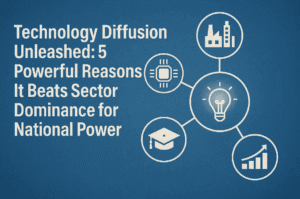Technology Diffusion Unleashed: 5 Powerful Reasons It Beats Sector Dominance for National Power
Jeffrey Ding’s groundbreaking analysis challenges conventional views of technological dominance, arguing that lasting national power stems not from leading sectors like EVs or semiconductors but from the diffusion of General Purpose Technologies (GPTs)—innovations like electricity or AI that drive productivity across industries. Historically, Britain’s Industrial Revolution success relied on iron-based machinery, while the U.S. outpaced Germany by standardizing electricity, proving that systemic adoption trumps niche monopolies.
For India, this underscores a strategic pivot: beyond chasing sectoral “wins,” prioritizing GPT diffusion through education, adaptable policies, and decentralized innovation is key. Success stories like India’s digital public infrastructure (UPI, Aadhaar) reveal how GPTs can revolutionize finance, governance, and inclusion. However, replicating this requires investing in vocational training, R&D collaboration, and open standards to embed technologies like AI or clean energy into everyday applications—from agriculture to healthcare.
While China excels in targeted industries, the U.S. maintains an edge through ecosystems enabling GPT scalability. India’s path hinges on fostering institutional agility, empowering SMEs, and balancing protectionism with global tech partnerships. Ultimately, national power lies not in isolated triumphs but in transforming society into a dynamic laboratory for GPT-driven progress.

Technology Diffusion Unleashed: 5 Powerful Reasons It Beats Sector Dominance for National Power
The quest for global influence has long been tied to technological prowess. Yet, as geopolitical rivalries intensify, a critical question emerges: Does a nation’s strength lie in dominating specific industries or in spreading transformative technologies across its economy? Political economist Jeffrey Ding’s groundbreaking analysis, The Rise of Great Powers, challenges conventional wisdom, arguing that the true engine of national power isn’t leading-sector dominance but the widespread adoption of General Purpose Technologies (GPTs). For nations like India, this insight could redefine strategies for growth and global competition.
Leading Sectors vs. GPTs: A Paradigm Shift
Traditional narratives link a nation’s rise to its dominance in cutting-edge industries—Britain’s textiles in the 18th century, Germany’s chemicals in the 19th, or Japan’s electronics in the 20th. However, Ding contends that these “leading sectors” offer fleeting advantages. Their benefits, while lucrative, remain confined to niche markets and are vulnerable to disruption.
In contrast, GPTs—technologies like steam engines, electricity, or AI—act as economic multipliers. They permeate diverse sectors, driving productivity gains and institutional innovation. For instance, Britain’s Industrial Revolution success stemmed not from textiles alone but from iron-based machinery that revolutionized manufacturing, transportation, and agriculture. Similarly, the U.S. outpaced Germany in the Second Industrial Revolution by rapidly diffusing electricity through standardized grids and workforce training, enabling systemic transformation.
Why GPTs Redefine Geopolitical Power
GPTs create a foundational infrastructure for innovation. Their adoption requires:
- Human Capital Depth: A workforce skilled in adapting technologies across industries.
- Institutional Flexibility: Policies that encourage interoperability, like standardizing digital payments or energy grids.
- Complementary Investments: Education, R&D, and infrastructure that support broad-based tech integration.
Ding highlights that nations fixated on leading sectors often neglect these pillars. Japan’s 1980s focus on consumer electronics, for example, overlooked the diffusion of computerization, limiting its long-term growth. Conversely, the U.S., despite losing ground in specific industries, maintained supremacy by fostering ecosystems where GPTs like the internet and semiconductors thrived across healthcare, finance, and logistics.
Implications for India: Beyond “National Champions”
India’s current strategy emphasizes sector-specific wins—semiconductors, EVs, or renewable energy. While these are vital, Ding’s framework suggests a dual focus:
- Prioritize Diffusion Over Silos: Mission-mode projects (e.g., solar parks) must coexist with systemic enablers. India’s digital public infrastructure (UPI, Aadhaar) exemplifies GPT-like impact, revolutionizing finance, governance, and e-commerce. Scaling similar models in AI, clean energy, or precision agriculture could yield economy-wide dividends.
- Invest in “Invisible” Foundations: GPT diffusion hinges on vocational training, R&D collaboration, and regulatory sandboxes. For instance, adapting AI for small farms, MSMEs, and healthcare demands localized R&D and skill hubs.
- Avoid the Monopoly Trap: Sector-specific protectionism (e.g., tariffs, import bans) may shield domestic industries but stifle GPT adoption. Open standards and global tech partnerships could accelerate learning.
The China-U.S. Contest: A Cautionary Tale
China’s dominance in EVs and 5G showcases leading-sector prowess. Yet, U.S. strengths in AI, quantum computing, and biotech—technologies with pervasive applications—highlight the GPT advantage. Ding warns that China’s top-down model, while effective in scaling industries, may lag in fostering organic innovation ecosystems essential for GPT diffusion.
The Road Ahead: Systemic Change Over Quick Wins
For India, the lesson is clear: National power stems not from isolated tech triumphs but from embedding technologies into societal DNA. This requires:
- Education Overhaul: Prioritizing STEM and adaptive learning to build a GPT-ready workforce.
- Policy Agility: Regulations that balance innovation incentives with public accountability (e.g., data privacy laws enabling AI growth).
- Decentralized Innovation: Empowering SMEs and startups to experiment with GPTs, moving beyond reliance on a few corporate giants.
In essence, while sectoral dominance grabs headlines, silent revolutions in technology diffusion determine lasting power. As India navigates the AI era and green transition, its success will hinge not on creating the next “national champion” but on becoming a laboratory for GPT-driven transformation.
You must be logged in to post a comment.